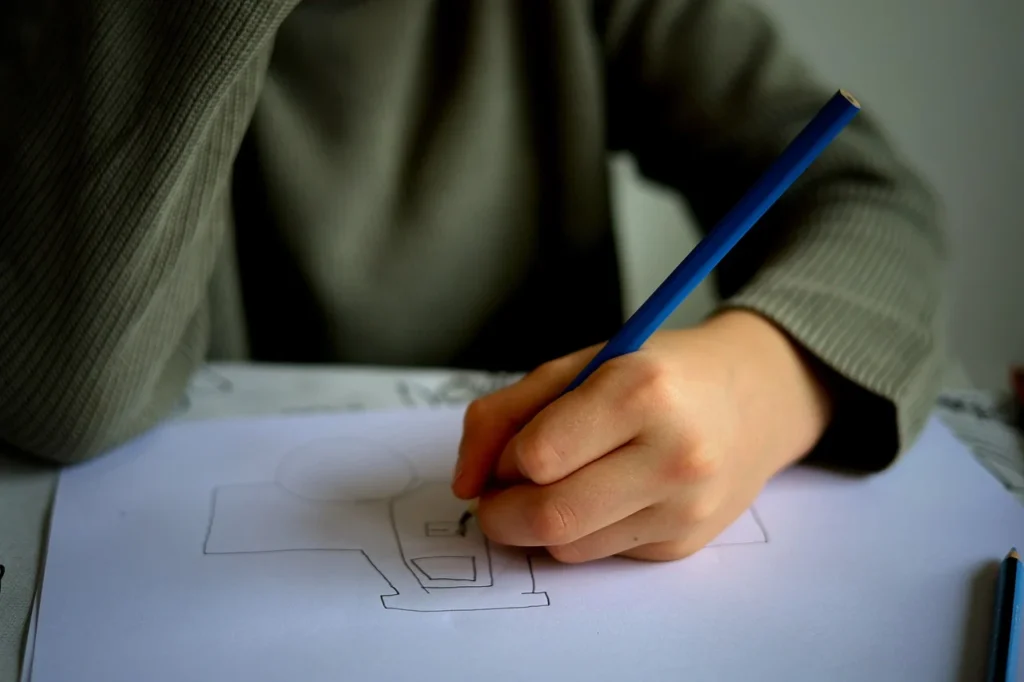“`html
Introduction to Projective Drawing
Projective drawing is a unique and insightful technique that has been harnessed within the fields of art therapy and psychological assessment. Originating in the early 20th century, the method affords individuals the ability to express their inner thoughts and emotions through the medium of drawing. Rooted in psychoanalytic theory, projective drawing serves as a visual means of understanding an individual’s subconscious processes and internal experiences.
The fundamental principles of projective drawing revolve around the idea that individuals project their inner conflicts, desires, and fears onto ambiguous stimuli—in this case, their drawings. As a form of expressive therapy, it provides a non-verbal outlet for emotions and psychoanalytic insights that might be difficult to articulate through words alone. This technique is pivotal in uncovering hidden aspects of an individual’s psyche, thereby enabling therapists to gain a deeper understanding of their clients’ inner worlds.
Projective drawing is characterized by its reliance on the spontaneous and uninhibited creation of images, often guided by minimal prompts from a therapist. These drawings can then be analyzed for themes, symbols, and patterns that may reflect the individual’s psychological state and emotional issues. The significance of this method extends beyond therapeutic settings, finding applications in educational environments, clinical assessments, and even corporate settings for team-building exercises.
Several key figures have significantly contributed to the development and popularization of projective drawing. Among them is Hermann Rorschach, whose inkblot test laid the groundwork for projective techniques. Additionally, figures like Florence Goodenough, known for the Draw-A-Man test, have further enhanced the practicality and utility of projective drawing. These pioneers recognized that the interpretative nature of drawing could provide invaluable insights into human behavior and emotional functioning.
Historical Background

Projective drawing has a rich history embedded within early psychological theories and methodologies. The roots of this practice trace back to the early 20th century, a period marked by burgeoning interest in the inner workings of the human mind. Sigmund Freud’s psychoanalytic theories, which emphasized the unconscious mind’s influence on behavior, laid the groundwork for the development of projective techniques.
The concept of projective drawing originates from Freud’s assertion that individuals often project their unconscious thoughts and feelings onto ambiguous stimuli. In the 1920s, this theory was operationalized by projective tests such as the Rorschach Inkblot Test, which utilized ambiguous images to elicit responses reflecting internal states. This era also witnessed the inception of the Thematic Apperception Test (TAT), developed by Henry Murray and Christiana Morgan. Although these tests didn’t involve drawing, they established the foundation for understanding how projective techniques could be used to explore the psyche.
By the mid-20th century, projective drawing emerged as a significant tool in psychological assessments. Florence Goodenough’s Draw-a-Man Test, developed in 1926, was one of the earliest structured attempts to use drawing as a projective measure. This test assessed children’s cognitive development through their drawings of human figures. Later, other variants such as the Draw-a-Person (DAP) test and the House-Tree-Person (HTP) test, contributed to refining projective drawing methods. These tests leveraged the idea that the way individuals represent objects on paper could reveal hidden aspects of their personality and emotional state.
Over the decades, projective drawing has evolved, influenced by advancements in psychological theory and practice. Researchers and clinicians have consistently refined their approaches to enhance the reliability and validity of these tests. The integration of projective drawing within psychological assessments has offered a unique window into understanding individuals’ inner worlds, utilizing creativity as a pathway to uncover deeper psychological layers.
Techniques and Tools Used in Projective Drawing

The practice of projective drawing encompasses an array of techniques and tools, each contributing uniquely to the interpretive potential of the artwork. One prevalent method is free drawing, where individuals are provided with blank paper and drawing utensils, allowing their subconscious to express freely without explicit directions. This technique is instrumental in uncovering thoughts and emotions that might not surface through structured activities. Free drawing can reveal underlying psychological states, personal conflicts, or unresolved issues.
Another notable approach is guided imagery, which incorporates relaxation and visualization exercises before the drawing begins. Participants are guided through scenarios by a facilitator and then instructed to depict their visualized experiences. This method fosters a deeper connection between the conscious and subconscious, aiding in the exploration of inner thoughts and feelings. Guided imagery often results in drawings rich in metaphor and symbolism, providing invaluable insights for therapists and analysts.
On the other hand, thematic instruction involves specific prompts or themes that guide the drawing process. Such themes can center around emotions, events, or relationships, prompting the participant to focus on particular aspects of their inner world. This technique is particularly useful in clinical settings, as it offers a structured way to delve into specific psychological areas.
The choice of materials also significantly influences the outcomes of projective drawing. Commonly utilized tools include pencils, markers, and a variety of paper types. Pencils, with their diverse grades and shading capabilities, allow for nuanced representation of textures and depth. Markers, known for their vibrant hues and bold lines, can evoke stronger emotional responses and highlight specific elements of the drawing. The paper type, whether it is smooth, textured, or colored, can further affect the drawing’s aesthetic and interpretive qualities. For instance, textured paper might encourage more expressive, tactile strokes, while smooth paper could lead to more detailed and intricate artwork.
Overall, the selection of techniques and materials in projective drawing plays a crucial role in the creation and interpretation of the images, providing a multifaceted approach to understanding the human psyche.
Psychological Applications and Interpretations
Projective drawings play a pivotal role in psychological assessments and therapy, offering a window into the inner workings of an individual’s mind. Psychotherapists often employ projective drawing techniques to assess and understand underlying emotions, thoughts, and personality traits that may not be readily accessible through other methods. These drawings serve as a non-verbal mode of expression, allowing clients, particularly those who may struggle with verbal communication, to convey their subconscious feelings and experiences.
In interpreting projective drawings, therapists engage in a meticulous analysis of various elements, including symbols, colors, and spatial arrangements. Symbols within a drawing can carry significant psychological weight. For instance, a recurring symbol like a house may represent one’s sense of security or family dynamics. The color choices made by the client can also be telling; for example, the pervasive use of dark colors might indicate feelings of sadness or anxiety.
Spatial arrangement within projective drawings is another critical factor in psychological interpretation. The placement of objects and figures can suggest relationships, power dynamics, or perceived levels of control. A person who positions themselves small and at the corner of the paper may reveal feelings of inferiority or marginalization. Conversely, someone who draws themselves prominently at the center may exude self-confidence or a need for attention.
These drawings provide therapists with a qualitative understanding of the client’s mindset. By analyzing projective drawings, therapists can uncover repressed emotions, identify potential conflicts, and gain insights into their client’s psychological state. Such drawings are particularly beneficial in child therapy, as young children often find it easier to express themselves through art rather than through words.
Overall, projective drawing serves as a valuable tool in the therapeutic process, enabling practitioners to delve deeper into an individual’s psyche and facilitate more effective therapeutic interventions.
Benefits of Projective Drawing in Therapy
Projective drawing, a technique in which individuals are encouraged to express their emotions and thoughts through drawing, has garnered significant attention in the field of therapy. It is especially beneficial for various populations, including children, trauma survivors, and individuals with mental health issues.
For children, projective drawing offers a unique avenue for self-expression. Young ones often struggle to articulate their emotions and experiences verbally. Drawing enables them to visualize and externalize their feelings, fostering a non-threatening medium for communication with therapists. For instance, a child who has experienced familial discord might depict their family members in a drawing, revealing insights into their emotional state and interpersonal relationships.
Trauma survivors also benefit profoundly from projective drawing. This method allows for the expression of complex and often repressed emotions associated with their traumatic experiences. Trauma can leave individuals feeling overwhelmed and unable to express their internal struggles. Through drawing, they can symbolically represent their trauma, helping them process and release pent-up emotions. A case study involving a trauma survivor who used projective drawing to depict scenes from their past reveals the technique’s potential in paving the way for healing and recovery.
Individuals with mental health issues, such as anxiety or depression, can also find solace in projective drawing. It serves as a therapeutic outlet for emotional release, providing a sense of relief and clarity. This technique can aid in the development of coping mechanisms by allowing individuals to visualize their stressors and anxieties. As clients draw, they sometimes uncover underlying issues previously unknown to them, which can be crucial in guiding therapeutic interventions.
The effectiveness of projective drawing in therapy has been demonstrated in various case studies. For example, a study involving individuals with generalized anxiety showed significant reductions in anxiety levels after participating in projective drawing sessions. By engaging with their subconscious through art, clients can foster insight, self-awareness, and emotional resilience, illustrating the profound impact of this therapeutic technique.
Training and Skills Required for Practitioners
Professional proficiency in projective drawing demands extensive and specialized training. Practitioners typically begin their journey with a foundational degree in psychology, counseling, or art therapy. This educational base equips them with the necessary theoretical knowledge and practical competencies required to effectively employ projective drawing techniques in clinical or therapeutic settings.
A critical next step involves obtaining credentials specific to projective drawing. These can include certifications from recognized art therapy associations or specialized training programs focused on projective techniques. This specialized training ensures that practitioners are adept at administering, interpreting, and utilizing projective drawings to gain insightful psychological information from clients’ artwork.
The importance of ethical considerations in the practice of projective drawing cannot be overstated. Practitioners must adhere to stringent ethical guidelines to protect client confidentiality and wellbeing. This includes obtaining informed consent, being transparent about the purposes and use of projective drawings, and ensuring that interpretations are conveyed with sensitivity and respect for the client’s experiences.
Cultural sensitivity is another essential skill for practitioners. Art and symbols can have vastly different meanings across cultures. Practitioners must possess a deep understanding of cultural context to accurately interpret projective drawings and avoid misunderstandings or misdiagnoses. Continuous education in cross-cultural competency is therefore vital for anyone using projective drawing in their practice.
Ongoing education and professional development are indispensable in this field. The landscape of psychological assessment and therapy is constantly evolving, and staying current with the latest research, techniques, and ethical standards is imperative. Engaging in workshops, seminars, and peer supervision sessions helps practitioners refine their skills and incorporate new insights into their practice.
Collaboration is a cornerstone of effective practice in projective drawing. Interdisciplinary collaboration among psychologists, art therapists, and counselors enhances the depth and breadth of interpretation, providing a more holistic understanding of the client’s condition. This collective approach enriches the practitioner’s perspective and fosters a more comprehensive treatment plan tailored to the individual’s needs.
Projective Drawing in Contemporary Research
Projective drawing has maintained its significance in contemporary psychological research, evolving alongside advances in academic and clinical studies. Current research is concentrated on evaluating the reliability and validity of projective drawing as a psychological assessment tool. Such studies aim to discern its effectiveness in uncovering unconscious processes and internal conflicts within individuals.
Recent findings have highlighted the strengths and limitations of projective drawing. On one hand, researchers advocate for its unique ability to facilitate expression among individuals, especially in populations where verbal articulation may be limited, such as children or trauma survivors. For instance, studies have shown that projective drawing can be an invaluable resource in pediatric psychology by aiding clinicians in accessing the child’s inner world without extensive verbal interaction. It fosters a non-threatening environment where emotions and experiences can be vaguely depicted through drawings, providing insights that structured tests may not reveal.
Conversely, ongoing debates within the academic community address concerns about the subjective interpretation of projective drawings. Critics argue that the lack of standardized scoring systems and the potential for clinician bias can skew results. Nevertheless, efforts are being made to develop more objective criteria and systematic approaches to minimize such biases, enhancing the credibility of projective drawing methods.
Furthermore, contemporary studies emphasize the need for integrating projective drawing with other diagnostic tools. Researchers support a multi-method assessment approach, combining projective techniques with quantitative measures to boost diagnostic accuracy and comprehensiveness. This symbiotic use ensures a more holistic understanding of the individual’s psychological state.
In modern psychology, the relevance of projective drawing continues to be reaffirmed, particularly in therapeutic settings. It remains a focal point for future research aimed at validating and refining its methodologies. By blending traditional approaches with innovative frameworks, projective drawing shows promise for maintaining its role as a vital instrument in psychological evaluation and therapy.
Conclusion and Future Directions
Projective drawing has shown its enduring significance as both a historical and contemporary tool for uncovering the depths of human cognition and emotion. This blog post has delved into various techniques utilized in projective drawing, illuminated its widespread applications from therapeutic settings to educational environments, and highlighted the multifaceted benefits it offers. Techniques such as the Rorschach inkblot test and the Draw-A-Person test demonstrate the complexity and utility of projective drawing, providing valuable insights into unconscious processes and internal states.
Historically, projective drawing has found its roots in psychoanalytic theory, offering a window into the unconscious mind. In contemporary contexts, it continues to evolve, incorporating new methodologies and adapting to diverse fields. The timeless relevance of projective drawing underscores its versatility and profound impact on fields such as psychology, art therapy, and even organizational development.
Looking to the future, there exists a wealth of potential directions for research and application of projective drawing. Advances in technology offer promising prospects for integrating digital tools and virtual reality into projective techniques, enhancing both the depth and breadth of analysis. Interdisciplinary approaches, blending insights from psychology, neuroscience, and technological innovation, can potentially unlock further dimensions of understanding human behavior and emotional states.
The landscape of projective drawing is rich with unexplored territories. As we continue to navigate these complexities, it is crucial to foster ongoing research and practical experimentation. By encouraging a multidisciplinary exploration, we can ensure that projective drawing remains a valuable and insightful technique for both current and future generations.
In closing, we invite practitioners, researchers, and enthusiasts alike to delve deeper into the realms of projective drawing. This unique and insightful technique holds vast potential for uncovering the inner workings of the human mind. Through dedicated exploration and innovative application, we can amplify our understanding and continue to discover new horizons within this captivating field.


